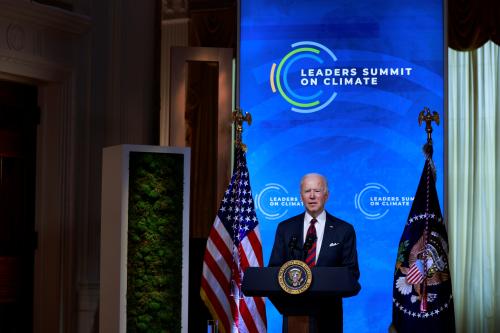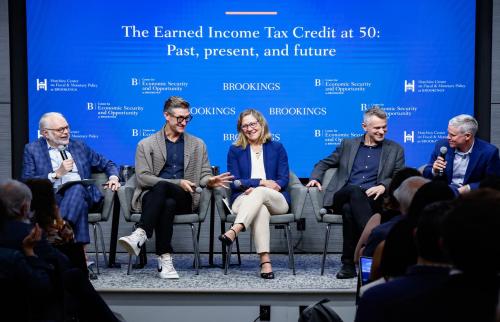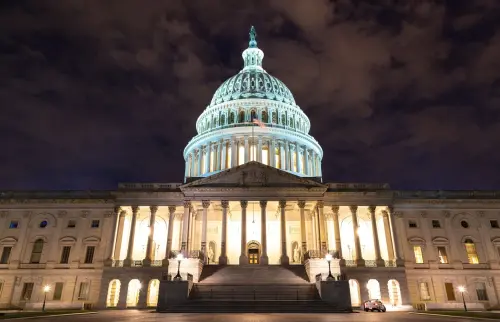This blog is part of a series highlighting policy proposals from Richard Reeves and Isabel Sawhill’s 2020 A New Contract with the Middle Class.
President Biden has proposed an ambitious domestic policy agenda meant to “build back better” and ensure that “every American enjoys a fair return for their work and an equal chance to get ahead.” The first plank of this agenda, the American Rescue Plan, became law this March and included checks for most American families, extended unemployment insurance, a temporary expansion of the child tax credit, and funding for vaccine distribution, among other provisions. President Biden has also pledged not to raise taxes on individuals making less than $400,000 a year.
Focus on the middle class
In A New Contract with the Middle Class, Richard Reeves and Isabel Sawhill propose a broad policy agenda focused on the middle class. One guiding theme of the Contract is to tax wealth and reward work.
The middle class has seen slow wage growth over the past 40 years. The second, third, and fourth earnings quintiles have seen median wage growth of seven, six, and 13 percent, respectively. Further, wages are the main source of income for middle-class families—more so than for the affluent, who get some of their income from capital, or for the poor, who receive a much higher share of their income from government transfers.

Even as wages picked up among the poor and the well-off in the recovery from the Great Recession, growth rates were much lower for middle-class workers—and that was before COVID-19 cratered the economy.
The transmission mechanism between economic growth and wage growth is breaking down. Why, for so many middle-class Americans has “economic growth become a spectator sport?” as Jared Bernstein, now member of Biden’s Council of Economic Advisors, memorably put it.
Why are wages lagging?
The traditional answer focused on productivity is not sufficient, Reeves and Sawhill argue. The more workers can produce, the more they will get paid. Getting higher wages, then, means raising productivity by increasing skills. This framework does not go far enough. As Michael Strain, director of economic policy studies at the American Enterprise Institute, writes, “it is most useful to think of wages as being determined by a combination of competitive market forces, bargaining power, and institutions.”
Reeves and Sawhill agree and place most weight on the shift in power from labor to capital. Economic power has become more concentrated and worker power has diminished. Workers are getting a smaller share of economic output, down to 58 percent from 66 percent in 1960. Just one-in-20 workers in the U.S. private sector are members of a union, down from its high of over one third in the 1950s.
Work first
Reeves and Sawhill argue that middle-class prosperity must be based primarily on rewarding work. “Americans value work far more than people in many other countries. Work is, of course, a means to an end—more income. But it is more than that. It is also a source of identity, self-respect, connection to others and sense of purpose. It is also essential to a well-functioning society. The pandemic revealed how much we depend on the workers who produce our food, deliver packages, care for the elderly, and clean our schools, offices, and hospitals.”
In service of better rewarding work, Reeves and Sawhill propose several pro-work policies:
- A $12 per hour federal minimum wage floor, but with higher rates in many areas
- Worker tax credits for the bottom half of wage earners, administered through an offset to their payroll taxes
- Tax incentives for corporations to train their workers and share profits broadly
- Labor law reform and workers’ councils to strengthen employee engagement and bargaining power
- Adequate fiscal and monetary stimulus to create and maintain full employment
Abolish income tax for most of the middle class…
Reeves and Sawhill pair these reforms with scholarships for service, while also giving the middle class a tax break. They propose eliminating income tax by raising the standard deduction for most middle-class families—specifically, any married couple making less than $100,000 a year or any single person making less than $50,000. This is an average tax cut of around $1,600 for middle-class families. It would also mean that for most Americans, “April 15 would be just another spring day,” as Columbia law professor, Michael Graetz puts it.
…by taxing wealth more
To make up for the lost revenue, Reeves and Sawhill propose taxing carbon and consumption. But they also argue for more taxation of capital. Capital is lightly taxed in the U.S. compared to earned income. This is backward. Instead of hitting work, Reeves and Sawhill argue, we should aim to tax wealth. Unfortunately, direct wealth taxes are tough to administer; it is far simpler to eliminate step-up basis at death and expand the estate tax. These two measures would raise around $135 billion a year. Reeves and Sawhill also support raising the corporate tax to 25 percent, expensing investment (to encourage growth) and eliminating corporate interest deductions (to put debt and equity financing on a level playing field).
This combination of rewarding work while taxing wealth would help to shift economic dynamics back towards the middle class, according to Reeves and Sawhill. A prosperous middle class provides the foundation stone for a strong society and a healthy democracy.
The Brookings Institution is committed to quality, independence, and impact.
We are supported by a diverse array of funders. In line with our values and policies, each Brookings publication represents the sole views of its author(s).







Commentary
Tax wealth, reward work
July 14, 2021